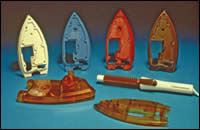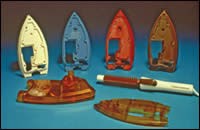No. 16 - Super-High-Heat Thermoplastics
The period from the mid-1960s to the early 1980s saw the emergence of a sub-group of engineering thermoplastics that can be called “super-high-heat” plastics.
The period from the mid-1960s to the early 1980s saw the emergence of a sub-group of engineering thermoplastics that can be called “super-high-heat” plastics. These high-performance materials included polyimides, polysulfones, aromatic polyesters, poly phenylene sulfide (PPS), polyetherimide (PEI), and liquid-crystal polymers (LCPs). They were designed for the aerospace and aircraft industries but gradually moved into electrical/electronic, medical, and telecommunications applications that required continuous-use temperatures above 300 F.
In 1965, Union Carbide developed polysulfone, one of the first thermoplastics targeted for long-term service beyond 300 F. The transparent material was used to make astronaut face shields and won use in the medical industry because of its sterilizability. The polysulfone family grew in 1972 with the introduction of polyethersulfone (PES) by ICI in the U.K. In October 1972, Plastics Technology reported that the new resins processed easily and operated continuously under load at 356 F. Subsequent additions to the sulfone polymer family included polyphenylsulfone from Amoco Chemicals (now Solvay Advanced Polymers) and Supradel HTS, an aromatic sulfone from Solvay that emerged just last year at the K 2004 show in Dusseldorf and has an HDT of 491 F at 264 psi.
Polyphenylene sulfide (PPS), developed by James T. Edmonds, Jr. and Harold Wayne Hill, Jr. at Phillips Chemical Co., became commercially available as Ryton in ’72. Applications exploited its exceptional resistance to thermal degradation, dimensional stability at high temperatures (HDTs of reinforced grades are well over 500 F), and chemical and flame resistance. Markets included electrical/electronics, automotive, and consumer appliances. Worldwide capacity today is 77 million lb/yr.
Another high-temperature polymer, polyamide-imide (PAI), was brought to market in 1973 by Dr. James Stephens at Amoco Chemicals (now Solvay). Polyamide-imides, as the name suggests, derive a synergy of properties from both polyamides and polyimides. High strength, melt processability, ex cept ional heat resistance, and broad chemical resistance are some. They have stable dielectric and mechanical properties up to 500 F. A key application was Ford engine components in the ’80s.
In 1981, Cela nese (later Ticona) launched liquid-crystal polymers, highly crystalline thermoplastics that self-oriented in the melt and delivered stable dimensions, chemical resistance, and high-heat resistance (HDT up to 585 F for reinforced grades) in thin-wall applications. The material withstands surface-mount soldering in electronics applications and offers high sterilizability for medical use.
A new “exotic” thermoplastic, polyetheretherketone (PEEK), was launched by ICI (later Victrex) in 1981. It had a 633 F melting point and could take continuous use at 500 F. First applications were wire and cable and parts exposed to steam and gamma radiation.
In ’82, GE Plastics launched Ultem PEI, a clear amorphous resin with higher heat performance than sulfones. Its long-term heat resistance (HDT of neat resin is around 400 F), dimensional stability, high strength, and broad chemical resistance made it suitable for microwave cookware, high-end connectors, and medical parts.
















